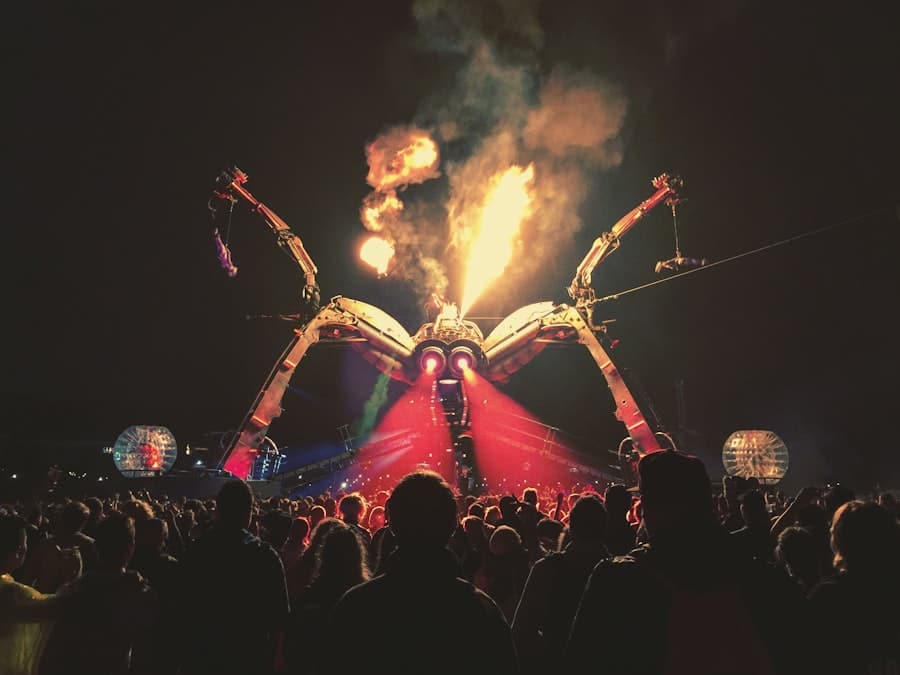Augmented Reality (AR) has emerged as a transformative technology that enhances the way audiences experience live events. By overlaying digital information onto the physical world, AR creates a hybrid environment where the real and virtual coexist, offering new dimensions of interaction and engagement. This technology has gained traction across various sectors, but its application in live events—ranging from concerts and sports to exhibitions and festivals—has been particularly noteworthy.
The integration of AR into these settings not only captivates audiences but also provides event organizers with innovative tools to enhance the overall experience. The rise of AR in live events can be attributed to advancements in mobile technology, including the proliferation of smartphones equipped with high-quality cameras and sensors. These devices enable users to access AR content seamlessly, making it easier for event organizers to implement AR features without requiring specialized hardware.
As audiences increasingly seek immersive experiences, the demand for AR applications in live events is expected to grow, pushing the boundaries of how we perceive and interact with entertainment.
Key Takeaways
- AR in live events enhances the overall experience by overlaying digital content onto the real world, creating an immersive and interactive environment for attendees.
- Current applications of AR in live events include interactive event maps, virtual merchandise try-ons, and live social media feeds integrated into the event experience.
- Potential future developments in AR for live events include personalized AR experiences, real-time language translation, and virtual meet-and-greets with performers.
- AR overlays can enhance fan engagement by providing interactive games, exclusive content, and behind-the-scenes access, creating a more personalized and memorable experience for attendees.
- AR in live events can improve accessibility and inclusivity by providing real-time captioning, audio descriptions, and customizable viewing options for attendees with disabilities.
Current Applications of AR in Live Events
Currently, AR is being utilized in a variety of ways to enhance live events, creating unique experiences that resonate with attendees. One prominent application is in sports events, where AR is used to provide real-time statistics and player information. For instance, during a football match, fans can point their smartphones at the field to see player stats, historical data, and even 3D replays of key moments.
This not only enriches the viewing experience but also fosters a deeper understanding of the game, allowing fans to engage with the sport on a more analytical level. Concerts and music festivals have also embraced AR technology to create visually stunning performances. Artists can incorporate AR elements into their shows, such as holographic visuals that interact with the music or digital avatars that perform alongside them.
A notable example is the Coachella Valley Music and Arts Festival, which has featured AR experiences that allow attendees to unlock exclusive content through their devices. These applications not only enhance the entertainment value but also encourage social sharing, as fans capture and share their augmented experiences on social media platforms.
Potential Future Developments in AR for Live Events
As technology continues to evolve, the potential for AR in live events is vast and exciting. One area ripe for development is the integration of artificial intelligence (AI) with AR systems. By leveraging AI algorithms, event organizers could create personalized experiences for attendees based on their preferences and behaviors.
For example, an AI-driven AR application could analyze a fan’s past interactions at events and suggest tailored content or experiences during a live show, enhancing engagement and satisfaction. Moreover, advancements in wearable technology could further revolutionize how AR is experienced at live events. Imagine attendees wearing smart glasses that provide real-time information about their surroundings without needing to look at their phones.
This hands-free experience could allow fans to immerse themselves fully in the event while still accessing valuable content. Such innovations could lead to more interactive environments where attendees can engage with both the physical and digital aspects of an event seamlessly.
Enhancing Fan Engagement with AR Overlays
AR overlays have proven to be a powerful tool for enhancing fan engagement at live events. By providing additional layers of information and interactivity, these overlays can transform a passive audience into active participants. For instance, during a live sports broadcast, viewers can use AR to access interactive replays or view player bios by simply pointing their devices at the screen.
This level of engagement not only keeps fans entertained but also encourages them to stay connected with the event for longer periods. In addition to providing information, AR overlays can facilitate social interactions among fans. For example, an event app could allow attendees to create and share custom AR filters or stickers that reflect their experience at the event.
This not only fosters a sense of community among fans but also encourages them to share their experiences on social media platforms, amplifying the event’s reach and visibility. By integrating social features into AR applications, event organizers can create a more vibrant atmosphere that extends beyond the physical venue.
Improving Accessibility and Inclusivity with AR in Live Events
One of the most significant advantages of AR technology in live events is its potential to improve accessibility and inclusivity for diverse audiences. For individuals with disabilities, AR can provide essential information that enhances their experience. For instance, AR applications can offer audio descriptions for visually impaired attendees or sign language interpretations for those who are deaf or hard of hearing.
By making these accommodations readily available through AR, event organizers can ensure that everyone has an equal opportunity to enjoy the event. Furthermore, AR can bridge language barriers by providing real-time translations of announcements or performances. This feature is particularly beneficial in multicultural settings where attendees may speak different languages.
By using AR to display translated text or subtitles during a performance or presentation, organizers can create a more inclusive environment that welcomes individuals from various backgrounds. As live events continue to evolve, prioritizing accessibility through innovative technologies like AR will be crucial in fostering a sense of belonging for all attendees.
Challenges and Considerations for Implementing AR in Live Events
Despite its numerous benefits, implementing AR in live events comes with its own set of challenges and considerations. One significant hurdle is the need for reliable internet connectivity. Many live events take place in large venues where network coverage may be inconsistent or insufficient to support high-bandwidth applications like AR.
Event organizers must ensure that robust Wi-Fi infrastructure is in place to facilitate seamless access to AR content for all attendees. Another challenge lies in the development and maintenance of AR content itself. Creating engaging and high-quality AR experiences requires collaboration between various stakeholders, including developers, designers, and event organizers.
This process can be resource-intensive and may require significant investment in both time and money. Additionally, as technology evolves rapidly, keeping AR content up-to-date and relevant poses an ongoing challenge for event organizers who want to provide fresh experiences for returning attendees.
The Role of AR in Creating Immersive Experiences at Live Events
AR plays a pivotal role in crafting immersive experiences that captivate audiences at live events. By blending digital elements with the physical environment, AR allows attendees to engage with their surroundings in novel ways. For example, during art exhibitions, visitors can use AR apps to view additional layers of information about the artwork or even see animations that bring static pieces to life.
This interactive approach transforms traditional viewing into an engaging exploration of creativity. Moreover, immersive storytelling through AR can enhance narrative-driven events such as theater performances or film screenings. By integrating AR elements into the storyline, creators can offer audiences a multi-dimensional experience that deepens emotional connections with the content.
Such innovations not only elevate the artistic experience but also encourage audience participation and investment in the story being told.
The Impact of AR on the Future of Live Events
The impact of AR on the future of live events is poised to be profound as technology continues to advance and audience expectations evolve. As more event organizers recognize the potential of AR to enhance engagement and create memorable experiences, we can expect an increase in its adoption across various sectors. This shift will likely lead to a new standard for live events where immersive technologies are seamlessly integrated into every aspect of planning and execution.
Furthermore, as audiences become more accustomed to interactive experiences through their everyday interactions with technology, their appetite for innovative features at live events will grow. This demand will drive continuous innovation within the industry as creators seek new ways to captivate audiences through augmented experiences. Ultimately, the integration of AR into live events will not only redefine how we experience entertainment but also shape the future landscape of audience engagement across all forms of media.
If you are interested in the latest emerging technologies, you may also want to check out this article on Wired.com’s focus on how emerging technologies. This article delves into the various ways that new technologies are shaping our world and offers insights into the future of innovation. It’s a fascinating read that complements the discussion on the future of AR in augmenting live events with digital overlays.
FAQs
What is AR (Augmented Reality)?
Augmented Reality (AR) is a technology that superimposes digital information such as images, videos, or 3D models onto the real world, typically viewed through a smartphone, tablet, or AR glasses.
How is AR being used in live events?
AR is being used in live events to enhance the audience’s experience by overlaying digital content onto the physical environment. This can include interactive maps, real-time information, virtual avatars, and more.
What are the benefits of using AR in live events?
Using AR in live events can provide a more immersive and engaging experience for attendees, enhance the visual appeal of the event, and provide valuable information in real-time.
What are some examples of AR being used in live events?
Examples of AR being used in live events include virtual event guides, interactive games or scavenger hunts, digital signage, and virtual product demonstrations.
What are the challenges of implementing AR in live events?
Challenges of implementing AR in live events include technical limitations, cost of development and implementation, and ensuring a seamless user experience for attendees.
What is the future of AR in augmenting live events with digital overlays?
The future of AR in live events is likely to involve more advanced and seamless integration of digital overlays, personalized experiences for attendees, and the use of AR for marketing and sponsorship opportunities.



